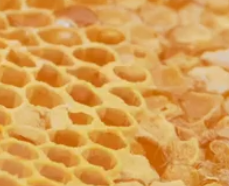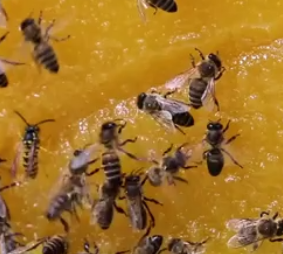| "Descrizione" by Qwerty (3763 pt) | 2023-Apr-26 15:18 |
Review Consensus: 9 Rating: 9 Number of users: 1
| Evaluation | N. Experts | Evaluation | N. Experts |
|---|---|---|---|
| 1 | 6 | ||
| 2 | 7 | ||
| 3 | 8 | ||
| 4 | 9 | ||
| 5 | 10 |
Beeswax, white and yellow is a complex mixture of about 300 components including fatty acids, fatty acid esters, hydrocarbons and other substances. It is produced industrially by solvent extraction (aqueous ethanol, aqueous methanol). It is hydrophobic.

What it is used for and where
Food
Ingredient listed in the European food additives list as E901 as a coating agent to impart lustre to food products, as a film to wrap cheese. Used in biopolymer coatings for food preservation (1).
Cosmetics
Binder agent. Ingredient that is used in cosmetic, food and pharmaceutical products as an anti-caking agent with the function of making the product in which it is incorporated silky, compact and homogenous. The binder, either natural such as mucilage, gums and starches or chemical, may be in the form of a powder or liquid.
Emulsion stabilizer. Emulsions are thermodynamically unstable. Emulsion stabilisers improve the formation and stability of single and double emulsions. It should be noted that in the structure-function relationship, molar mass plays an important role.
Fragrance. It plays a decisive and important role in the formulation of cosmetic products as it provides the possibility of enhancing, masking or adding fragrance to the final product, increasing its marketability. The consumer always expects to find a pleasant or distinctive scent in a cosmetic product.
Skin conditioning agent. It is the mainstay of topical skin treatment as it has the function of restoring, increasing or improving skin tolerance to external factors, including melanocyte tolerance. The most important function of the conditioning agent is to prevent skin dehydration, but the subject is rather complex and involves emollients and humectants that can be added in the formulation.
Viscosity control agent. It controls and adapts viscosity to the required level for optimal chemical and physical stability of the product and dosage in gels, suspensions, emulsions, solutions.

Medical
Beeswax is used in traditional medical science in the treatment of wounds, abrasions and currently for its antibacterial and antimicrobial properties in combating bacteria, particularly Gram-positive bacteria (2). It has proved useful against psoriasis, atopic dermatitis, mucositis and is a protector of the gastrointestinal mucosa (3).
Safety
EFSA's Food Additives Panel concluded that the use of beeswax as an additive for existing food uses and the proposed new food use does not raise safety concerns (4)
CAS 8006-40-4 (yellow beeswax) 8012-89-3 (white beeswax)
EC number 232-383-7
References_____________________________________________________________________
(1) Oliveira, V.R.L., Santos, F.K.G., Leite, R.H.L., Aroucha, E.M.M. and Silva, K.N.O., 2018. Use of biopolymeric coating hydrophobized with beeswax in post-harvest conservation of guavas. Food chemistry, 259, pp.55-64.
(2) Fratini, F., Cilia, G., Turchi, B. and Felicioli, A., 2016. Beeswax: A minireview of its antimicrobial activity and its application in medicine. Asian Pacific Journal of Tropical Medicine, 9(9), pp.839-843.
(3) Molina, V., Mas, R. and Carbajal, D., 2015. D-002 (beeswax alcohols): concurrent joint health benefits and gastroprotection. Indian Journal of Pharmaceutical Sciences, 77(2), p.127.
(4) Aguilar, F., Autrup, H., Barlow, S., Castle, L., Crebelli, R., Dekant, W., Engel, K.H., Gontard, N., Gott, D., Grilli, S. and Gürtler, R., 2007. Beeswax (E 901) as a glazing agent and as carrier for flavours scientific opinion of the panel on food additives, flavourings, processing aids and materials in contact with food (AFC). EFSA J, 645, pp.1-28.
Abstract. The Panel considered that the data on beeswax itself were insufficient to establish an ADI, but concluded that the safety of beeswax could be assessed, based on available scientific literature on the main constituents of beeswax and plant waxes showing chemical structural similarities to beeswax, published since the last SCF evaluation. The Panel concluded that the use of beeswax as an additive for the existing food uses and the proposed new food use is not of safety concern. The Panel noted that NOAELs identified in the toxicological studies on the main constituents of beeswax and plant waxes showing chemical structural similarities were 10 to 50 times higher than the very conservative exposure estimate of 22 mg/kg bw/day and were generally the highest doses tested. The Panel considered such margins of safety to be adequate for the assessment of beeswax which consists of components poorly absorbed from the gastrointestinal tract, which if absorbed to any extent at all, would be metabolised to compounds also occurring endogenously.
Zhang, Y., Simpson, B.K. and Dumont, M.J., 2018. Effect of beeswax and carnauba wax addition on properties of gelatin films: A comparative study. Food bioscience, 26, pp.88-95.
Abstract. Different levels of beeswax (B) or carnauba wax (C) were added into gelatin (G) at 5%, 10%, and 15% (w/w) to prepare films containing glycerol as a plasticizer. Although the wax addition increased the opacity and yellowness of gelatin films, both the UV/visible light and water vapor barriers were successfully improved gradually with increasing wax levels, and B was more effective than C. Addition of 10% and 15% wax significantly reduced the water solubility and WVP (P ≤ 0.05). However, the mechanical properties of gelatin-wax films were not strengthened compared with control. As wax levels increased, the resulting films became more brittle, harder, and less stretchable. SEM showed GB films have more uniform surfaces and compact cross-sections compared with GC films. All films showed antioxidant activity against DPPH and hydroxyl radicals, and iron reducing; however, the effects obtained with the gelatin-wax films were not significantly different from the G films (P > 0.05). Based on FTIR analysis, all films showed amide absorption regions, but GB films showed higher intensity of absorption peaks for lipid functional groups than GC films. Wax addition improved thermal stability of films suggesting an interaction between wax and gelatin. The improved barrier properties and thermal stability of the gelatin-wax films suggest that they can be used to protect foods from deterioration, and B was found to be better than C when added in gelatin films.
| Evaluate |

